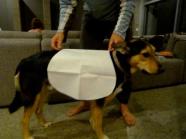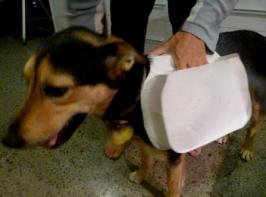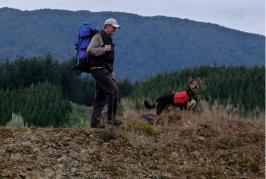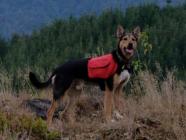Dog's outdoor carry bag
Year 11 Materials student Hanne Roberti designed and constructed a prototype carry bag for her family dog, in a unique project that married strong functional modelling with fabric construction techniques.

The project was part of the Bags of Difference unit run by Hanne’s Materials teacher Barbara Knight. The unit required students to develop a bag or carrier item to suit a specific client’s need and to 'make a difference' for the end user. The students had to develop a prototype and comment on further improvements that could be made to the design.
Issue
Hanne and her family are keen trampers and often take their dog Jake along with them on short trips. Hanne and her family prefer to travel as light as possible. However, in addition to their own food, protective clothing, and safety supplies, they have to carry Jake’s food and plastic dog-poo bags.
Hanne determined that, as a two year old Huntaway/German Shepherd cross (both strong working breeds), Jake could easily carry his own supplies. So she decided to solve her families’ by developing a carrier bag that Jake could wear.
Brief

To develop her , Hanne consulted with her parents – who acted as the clients and representatives of Jake. Because Jake was the end user, his safety and comfort were important considerations when developing the specifications of the carry bag.
Unlike a standard coat made for a dog, Hanne’s would need to be a functional piece of outdoor equipment – with materials and design that would protect him from cold and wet weather. It would be used on rough trails and environments where Jake would brush past bushes and trees, so it also needed to be durable and fit his body well to prevent rips and snags.
Other specifications included:
- waterproof lining to protect items carried in the bag
- bright colour, so Jake could be seen easily in the dark or in dense bush
- contact details on the inside of the bag in case Jake or the bag got lost
- comfortable on Jake and not restricting his movements.
Modelling

To get the fit of the carry bag right for Jake, Hanne began a thorough modelling She started with simple paper pattern fittings on Jake. Hanne’s initial pattern designs were too large and bulky on Jake’s slim frame, and refining the shape and size took some time.
Hanne also trialled a human 'camel-back' water bag on Jake, but this wasn’t comfortable enough around his chest and stomach. Hanne eventually settled on a saddle pannier style that went across his back and shoulders, with pocket bags on either side of his body. Further size refinement produced the perfect shape for Jake.
Outcome

Hanne constructed her final from a tough bright red material lined with black waterproof fabric. Two lined pocket pouches with covered flaps and zip pockets provided room to carry Jake’s food, plastic bags, and his lead. Hanne also designed adjustable straps around his middle and stretchy straps across his front to allow for comfort and freedom of movement.
Testing

Hanne’s fitness-for-purpose testing of her prototype proved the carrier bag met all the requirements of her . During testing, Jake was able to run through bush and up hills without being restricted. The pockets were big enough to comfortably hold supplies and the bright red colour made it easy to see in the bush.
After consulting with her clients, Hanne identified areas for future improvements to the prototype, including:
- reflective strips to make the bag easier to see at night
- padding on the straps that go under his legs to prevent chafing
- waterproof materials for the outside of the coat as well as the interior.
Hanne, her parents, and Jake are very happy with the prototype she developed. Hanne’s neighbour has also expressed interest in purchasing any future models of the carry bag.
Teacher comment
I was particularly impressed with Hanne’s on-going functional modelling throughout this project, which ensured the pattern and mock-ups were the right size, shape and fit, and were functional and non-restrictive for Jake.
Hanne's on-going consultation with her clients was also crucial to ensuring the saddle bag was a successful for Jake. Her comprehensive evaluation of potential future improvements showed thoughtful insight that linked directly to modelling and environment testing.

